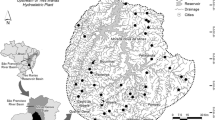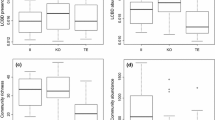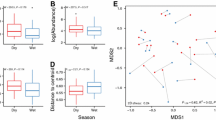Abstract
The regional occupancy and local abundance of species are thought to be strongly correlated to their body size, niche breadth and niche position. The strength of the relationships among these variables can also differ between different organismal groups. Here, we analyzed data on stream diatoms and insects from a high-latitude drainage basin to investigate these relationships. To generate measures of niche position and niche breadth for each species, we used sets of local environmental and catchment variables separately, applying the outlying mean index analysis. Beta regression and negative binomial generalized linear models were run to predict regional occupancy and mean local abundance, respectively. We found a positive occupancy–abundance relationship in both diatoms and insects, and that niche-based variables were the main predictors of variation in regional occupancy and local abundance. This finding was mainly due to local environmental niche position, whereas the effects of niche breadth on regional occupancy and local abundance were less important. We also found a relationship between body size and local abundance or regional occupancy of diatoms. Our results thus add to current macroecological research by emphasizing the strong importance of niche position rather than niche breadth and body size for regional occupancy and local abundance in rarely studied organisms (e.g., diatoms and insects) and ecosystems (i.e., wilderness streams).






Similar content being viewed by others
References
Beven KJ, Kirkby MJ (1979) A physically based, variable contributing area model of basin hydrology. Hydrolog Sci Bull 24:43–69
Blackburn TM, Gaston KJ, Quinn RM, Arnold H, Gregory RD (1997) Of mice and wrens: the relation between abundance and geographic range size in British mammals and birds. Philos Trans R Soc Ser B 352:419–427
Blackburn TM, Cassey P, Gaston KJ (2006) Variations on a theme: sources of heterogeneity in the form of the interspecific relationship between abundance and distribution. J Anim Ecol 75:1426–1439
Borregaard MK, Rahbek C (2010) Causality of the relationship between geographic distribution and species abundance. Q Rev Biol 85:3–25
Brown JH (1984) On the relationship between abundance and distribution of species. Am Nat 124:255–279
Brown JH, Maurer BA (1987) Evolution of species assemblages: effects of energetic constraints and species dynamics on the diversification of the North American avifauna. Am Nat 130:1–17
Brown JH, Maurer BA (1989) Macroecology: the division of food and space among species on continents. Science 243:1145–1150
Burnham KP, Anderson DR (2002) Model selection and multimodel inference: a practical information-theoretic approach. Colorado State University, Fort Collins
Chessel D, Dufour AB and Dray S (2012) ADE-4: analysis of ecological data. exploratory and euclidean methods in environmental sciences. In: http://CRAN.R-project.org/package=ADE4. Accessed 22 Sep 2016
Corkum LD (1992) Spatial distribution patterns of macroinvertebrates along rivers within and among biomes. Hydrobiologia 239:101–114
Cowley MJR, Thomas CD, Wilson RJ, Léon-Cortés JL, Gutiérrez D, Bulman CR (2001) Density-distribution relationships in British butterflies: II. An assessment of mechanisms. J Anim Ecol 70:426–441
Crist EP, Cicone RC (1984) A physically-based transformation of thematic mapper data—the TM tasseled cap. IEEE Trans. Geiosci Remote Sens 3:256–263
Doledéc S, Chessel D, Gimaret-Carpentier C (2000) Niche separation in community analysis: a new method. Ecology 81:2914–2927
Felsenstein J (1985) Phylogenies and the comparative method. Am Nat 125:1–15
Ferrari SLP, Cribari-Neto F (2004) Beta Regression for modelling rates and proportions. J. Appl. Stat. 31(7):799–815
Gaston KJ (1994) Rarity. Chapman & Hall, London
Gaston KJ, Blackburn TM (2000) Pattern and process in macroecology. Blackwell, Oxford
Gaston KJ, Blackburn TM, Gregory RD, Greenwood JJD (1998) The anatomy of the interspecific abundance-range size relationship for the British avifauna: I. Spatial patterns Ecol Lett 1:38–46
Gaston KJ, Blackburn TM, Greenwood JJD, Gregory RD, Quinn RM, Lawton JH (2000) Abundance-occupancy relationships. J Appl Ecol 37:39–59
Gregory RD, Gaston KJ (2000) Explanations for commonness and rarity in British breeding birds: separating resource use and resource availability. Oikos 88:515–526
Hanski I, Kouki K, Halkka A (1993) Three explanations of the positive relationship between distribution and abundance of species. In: Ricklefs RE, Schluter D (eds) Species diversity in ecological communities: historical and geographical perspectives. University of Chicago Press, Chicago, pp 108–116
Heino J (2005) Positive relationship between regional distribution and local abundance in stream insects: a consequence of niche breadth or niche position? Ecography 28:345–354
Heino J (2013) Environmental heterogeneity, dispersal mode and co-occurrence in stream macroinvertebrates. Ecol Evol 3:344–355
Heino J, de Mendoza G (2016) Predictability of stream insect distributions is dependent on niche position, but not on biological traits or taxonomic relatedness of species. Ecography 39:001–011
Heino J, Gönroos M (2014) Untangling the relationships among regional occupancy, species traits, and niche characteristics in stream invertebrates. Ecol Evol 4:1931–1942
Heino J, Soininen J (2006) Regional occupancy in unicellular eukaryotes: a reflection of niche breadth, habitat availability or size-related dispersal capacity? Freshw Biol 5:672–685
Heino J, Virtanen R (2006) Relationships between distribution and abundance vary with spatial scale and ecological group in stream bryophytes. Freshw Biol 51:1879–1889
Hjort J, Luoto M (2006) Modelling patterned ground distribution in Finnish Lapland: an integration of topographical, ground and remote sensing information. Geogr Ann 88:19–29
Hoffsten PO (2004) Site-occupancy in relation to flight morphology in caddisflies. Freshw Biol 49:810–817
Holt AR, Gaston KJ (2003) Interspecific abundance–occupancy relationships of British mammals and birds: is it possible to explain the residual variation? Glob Ecol Biogeogr 12:37–46
Hurlbert AH, White EP (2007) Ecological correlates of geographical range occupancy in North American birds. Glob Ecol Biogeogr 16:764–773
Hutchinson GE (1957) Concluding remarks. Cold Spring Harb Symp Quant Biol 22:145–159
Hutchinson GE, MacArthur RH (1959) A theoretical ecological model of size distributions among species of animals. Am Nat 93:117–125
Hynes HBN (1970) The Ecology of Running Waters. University of Toronto Press, Toronto
Jenkins DG, Brescacin CR, Duxbury CV, Elliott JA, Evans JA, Grablow KR, Hillegass M, Lyon BN, Metzger GA, Olandese ML, Pepe D, Silvers GA, Suresch HN, Thompson TN, Trexler CM, Williams GE, Williams NC, Williams SE (2007) Does size matter for dispersal distance? Glob Ecol Biogeogr 16:415–425
Johnson RK, Goedkoop W, Sandin L (2004) Spatial scale and ecological relationships between the macroinvertebrate communities of stony habitats of streams and lakes. Freshw Biol 49:1179–1194
Kelly MG, Cazaubon A, Coring E, Dell’Uomo A, Ector L, Goldsmith B, Guasch H, Hürlimann J, Jarlman A, Kawecka B, Kwandrans J, Laugaste R, Lindstrom EA, Leitao M, Marvan P, Padisak J, Pipp E, Prygiel J, Rott E, Sabater S, Van Dam H, Vizinet J (1998) Recommendations for the routine sampling of diatoms for water quality assessments in Europe. J Appl Phycol 10:215–224
Luiz OJ, Madin JS, Robertson DR, Rocha LA, Wirtz P, Floeter SR (2012) Ecological traits influencing range expansion across large oceanic dispersal barriers: insights from tropical Atlantic reef fishes. Proc Roy Soc B 279:1033–1040
McGill B, Collins C (2003) A unified theory for macroecology based on spatial patterns of abundance. Evol Ecol Res 5:469–492
Mykrä H, Ruokonen T, Muotka T (2006) The effect of sample duration on the efficiency of kick-sampling in two streams with contrasting substratum heterogeneity. Verh Internat Verein Limnol 29:1351–1355
National Board of Waters and the Environment (1981) Vesihallinnonanalyysimenetelmät. Publ Nat Board Wat Finland Report 213:1–136
National Land Survey of Finland (2000c) Digital elevation model. PaITuli spatial data service. In: https://research.csc.fi/paituli. Accessed 15 July 2016
National Land Survey of Finland (2010a) Basic map 1: 20 000. PaITuli spatial data service. In: https://research.csc.fi/paituli. Accessed 15 July 2016
National Land Survey of Finland (2010b) Topographic database 1: 10 000. PaITuli spatial data service. In: https://research.csc.fi/paituli. Accessed 15 July 2016
Passy SI (2007) Differential cell size optimization strategies produce distinct diatom richness–body size relationships in stream benthos and plankton. J Ecol 95:745–754
Passy SI (2012) A hierarchical theory of macroecology. Ecol Lett 15:923–934
Poff NL (1997) Landscape filters and species traits: towards mechanistic understanding and prediction in stream ecology. J North Am Benthol Soc 16:391–409
R Core Team (2013) R: A Language and Environment for Statistical Computing. R Foundation for Statistical Computing, Vienna. Available at: http://www.R-project.org/. Accessed 10 June 2016
Rimet F, Bouchez A (2012) Life-forms, cell-sizes and ecological guilds of diatoms in European rivers. Knowl Manag Aquat Ecosyst 406:1–14
Saito VS, Soininen J, Fonseca Gessner AA, Siqueira T (2015) Dispersal traits drive the phylogenetic distance decay of similarity in neotropical stream metacommunities. J Biogeogr 42:2101–2111
Sandin L, Johnson RK (2004) Local, landscape and regional factors structuring benthic macroinvertebrate assemblages in Swedish streams. Landscape Ecol 19:501–514
Schmera D, Eros T, Heino J (2013) Habitat filtering determines spatial variation of macroinvertebrate community traits in northern headwater streams. Comm Ecol 14:77–88
SFS-EN 14407 (2005) Water quality. Guidance standard for the identification, enumeration and interpretation of benthic diatom samples from running waters. Suomen standardisoimisliitto SFS ry, Helsinki
Siqueira T, Bini LM, Cianciaruso MV, Roque FO, Trivinho-Strixino S (2009) The role of niche measures in explaining the abundance-distribution relationship in tropical lotic chironomids. Hydrobiologia 636:163–172
Slatyer RA, Hirst M, Sexton JS (2013) Niche breadth predicts geographical range size: a general ecological pattern. Ecol Lett 16:1104–1114
Snoeijs P, Busse S, Potapova M (2002) The importance of diatom size in community analysis. J Phycol 38:265–272
Soininen J, Heino J (2005) Relationships between local population persistence, local abundance and regional occupancy of species: patterns in diatoms of boreal streams. J Biogeogr 32:1971–1978
Soininen J, Bartels P, Heino J, Luoto M, Hillebrand H (2015) Toward more integrated ecosystem research in aquatic and terrestrial environments. Bioscience 216:1–9
Tachet H, Richoux P, Bourneau M, Usseglio-Polatera P (2010) Freshwater Invertebrates, Systematics, Biology, Ecology. CNRS Editions, Paris
Tales E, Keith P, Oberdorff T (2004) Density-range size relationship in French riverine fishes. Oecologia 138:360–370
Tolonen KE, Leinonen K, Marttila H, Erkinaro J, Heino J (2017) Environmental predictability of taxonomic and functional community composition in high-latitude streams. Freshw Biol 62:1–16
Tonkin JD, Arimoro FO, Haase P (2016) Exploring stream communities in a tropical biodiversity hotspot: biodiversity, regional occupancy, niche characteristics and environmental correlates. Biodivers Conserv 25:975–993
Venier LA, Fahrig L (1996) Habitat availability causes the species distribution-abundance relationship. Oikos 76:564–570
Vinson MR, Hawkins CP (1998) Biodiversity of stream insects: variation at local, basin, and regional spatial scales. Annu Rev Entomol 43:271–293
Wentworth CK (1992) A scale of grade and class terms for clastic sediments. J Geology 30:377–392
White EP, Ernest SKM, Kerkhoff AJ, Enquist BJ (2007) Relationships between body size and abundance in ecology. TREE 22:323–330
Wrona FJ, Reist JD, Amundsen Arne, Chambers PA, Christoffersen K, Culp JM, di Cenzo PD, Forsström L, Hammar J, Heino J, Heikkinen RK, Kahilainen KK, Lesack L, Lehtonen H, Lento J, Luoto M, Marsh P, Marcogliese DJ, Moquin PA, Mustonen T, Prowse TD, Power M, Rautio M, Swanson H, Thompson M, Toivonen H, Vasiliev V, Virkkala R, Zavalko S (2013) Freshwater ecosystems. In: Meltofte H (ed) Arctic Biodiversity Assessment. Status and Trends in Arctic Biodiversity. Conservation of Arctic Flora and Fauna, Arctic Council, Iceland, pp 335–377
Zeileis A, Kleiber C, Jackman S (2008) Regression models for count data in R. J Stat Software 27:1–25
Acknowledgements
MPR would like to thank CAPES Foundation-Brazil for her full PhD grant acquired and also thank Finnish Environment Institute for receiving her as a visiting researcher. We thank Sirkku Lehtinen, Olli-Matti Kärnä and Laura Tokola for assisting with field sampling, and Sylvain Doledéc, Jari Ilmonen and Lauri Paasivirta for insect body size information. Lauri Paasivirta identified the larvae of non-biting midges and Jari Ilmonen those of blackflies. We thank Olli-Matti Kärnä for providing the map of the study area.
Author information
Authors and Affiliations
Contributions
MPR and JH conceived the main ideas and led the writing of the manuscript. LMB and TS contributed to the statistical analyses and writing of the manuscript. JH contributed to gathering the catchment variables and commented on the manuscript. MG led the field sampling and identification of insect samples. ML and SMK did the identification of diatom samples. All authors commented on and approved the final manuscript version.
Corresponding author
Ethics declarations
Funding
MPR is funded by thank CAPES Foundation-Brazil (Grant number 11877-13-8). TS is funded by Grant #2013/50424-1, São Paulo Research Foundation (FAPESP). Work by LMB have been continuously supported by CNPq Productivity Grants and is developed in the context of National Institutes for Science and Technology (INCT) in Ecology, Evolution and Biodiversity Conservation, supported by MCTIC/CNPq (proc. 465610/2014-5) and FAPEG. This study was also supported by grants from the Academy of Finland to JHeino and JHjort.
Conflict of interest
The authors declare that they have no conflict of interest.
Additional information
Communicated by Bryan Brown.
Electronic supplementary material
Below is the link to the electronic supplementary material.
Rights and permissions
About this article
Cite this article
Rocha, M.P., Bini, L.M., Siqueira, T. et al. Predicting occupancy and abundance by niche position, niche breadth and body size in stream organisms. Oecologia 186, 205–216 (2018). https://doi.org/10.1007/s00442-017-3988-z
Received:
Accepted:
Published:
Issue Date:
DOI: https://doi.org/10.1007/s00442-017-3988-z




